Outdoor lights controlled by a motion sensor is a great way to make your home more secure and energy efficient. They detect movement or light levels and turn on the light when necessary, eliminating the need for manual operation or timers. Motion sensor lights are commonly used around driveways, walkways, gates, porches and other entrances to provide illumination for visitors or passers by at night. But, is a PIR or microwave sensor light your best option?
In this article, I will be explaining the different sensors we can use to control our light fittings. I will explain how they work and outline the features and benefits of each type. This will help you make an informed decision when purchasing lighting with a built-in sensor, or controlled by a separate remote sensor.
The three most popular sensors used to control your lights are PIR sensors, microwave sensors and photocell sensors.
PIR sensors and microwave sensors are triggered by movement whereas photocell sensors are triggered by the ambient light level.

Passive Infra-Red detector (PIR Lights)
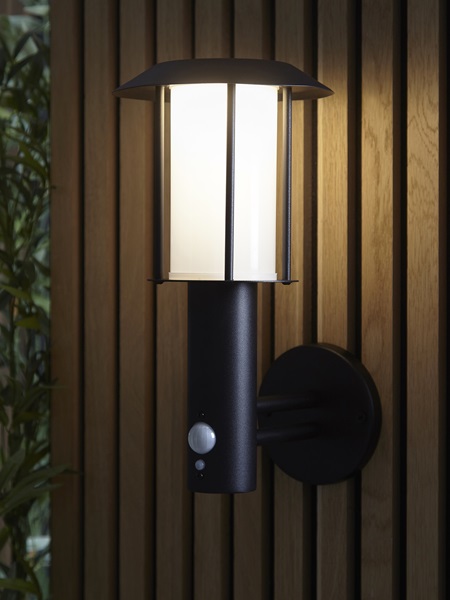
As its name suggests, a passive infra-red detector (commonly referred to as a PIR) measures infra-red radiation (for example body heat) that is emitted from objects within its field of view within the angle and distance of detection.
It does not strictly detect movement, but detects the difference in heat within the detection zone. There are two slots within a PIR, each one is constantly measuring the infra-red in front of it. These slots are covered by a segmented Fresnel lens which means multiple beams are detected by the sensor at once. The design of this lens is vital in determining the beam width, range of detection and sensitivity of the PIR sensor.
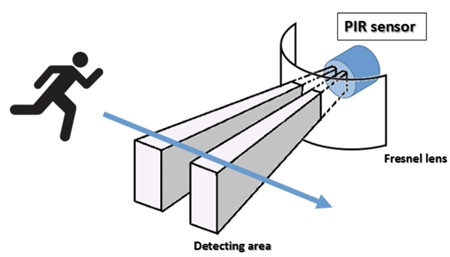
When a body crosses a beam from the first slot, the detector realises there is a heat differential and triggers the automatic activation of your lights. When the two slots detect an equal amount of infra-red, they deactivate after a set time. As long as somebody is moving in front of the sensor, then it will remain on.
Interestingly, if the ambient temperature is around 37 degrees C, the same as the human body temperature, then no activation will happen as there is no differential in heat detected.
Microwave Sensor Lights
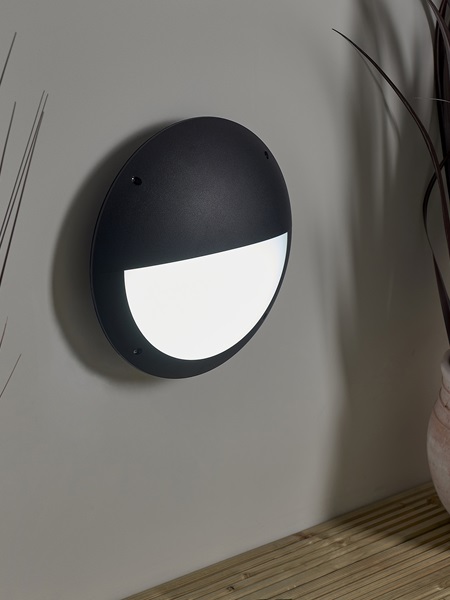
A microwave sensor emits several low-level pulses of electromagnetic radiation which strike a target and are then bounced back to the receiving sensor. It then utilises the time it takes for the signal to return and constantly compares the results. Any change in the result is an indication of movement and the light is activated.
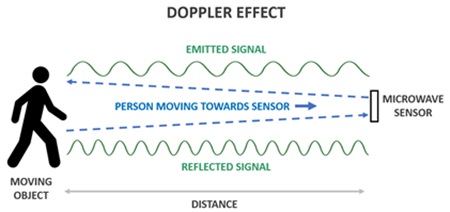
The sensor is very small and can usually be housed within the light fixture so as not to alter the overall look of the light fitting. The operate very efficiently through the shades and do not require any holes to be cut into the body, so the IP rating is not affected.
PIR Sensor Advantages
- The PIR Sensor is a passive device which does not release any electromagnetic waves and therefore eliminates the possibility of interference when operating around sensitive equipment.
- The PIR is inexpensive to manufacture and is easily integrated into cost effective security lighting.
- Some motion sensor lights offer adjustable activation time so that you can control the length of time the light stays on after detection of movement; this allows you to customize the lighting for your specific needs.
- Commonly available with a manual override, so can be switched on manually.
PIR Sensor Disadvantages
- A PIR works by sensing in cycles which means if a person is sat still for a set time in the detection zone, the next cycle will determine that the space has been vacated and switch off.
- The PIR detector could fail to detect a person walking directly towards the sensor as they are not crossing the detection beams.
- PIRs can be under sensitive within locations of higher background temperatures and over sensitive within locations of lower temperatures.
- They can be susceptible to false alarms where natural movement such as wind or leaves could possibly set them off.
Microwave Sensor Advantages
- Microwave sensors can be used in virtually any environment such as in areas of high heat or wet conditions and as a result, are one of the most adaptable sensors available.
- Microwave sensors can penetrate walls and windows and because of this they cover a wider area of detection, for example large outdoor spaces; they are frequently used where there is a need to protect large property areas.
- They are constantly sensing for movement and therefore will not turn off unnecessarily.
- Microwave sensors have fewer false alarms increasing the accuracy of detection.
Microwave Sensor Disadvantages
- While microwave sensors can penetrate walls and glass and could be seen as being a benefit, the sensor will not detect through metal therefore it has an inability to detect movement in areas behind metal objects.
- This feature may also give false detections from adjacent rooms or spaces for example where a sensor is detecting next to a main road or another inhabited room.
- It’s also important to note that microwave sensors, by design, can be triggered by various movements, including heavy rain. Microwave sensors are more sensitive and may detect movement caused by a heavy downpour.
- They are typically more expensive to purchase and have a higher sensitivity, resulting in possible activation without obvious reason.
Photocells (Dusk to dawn sensors)
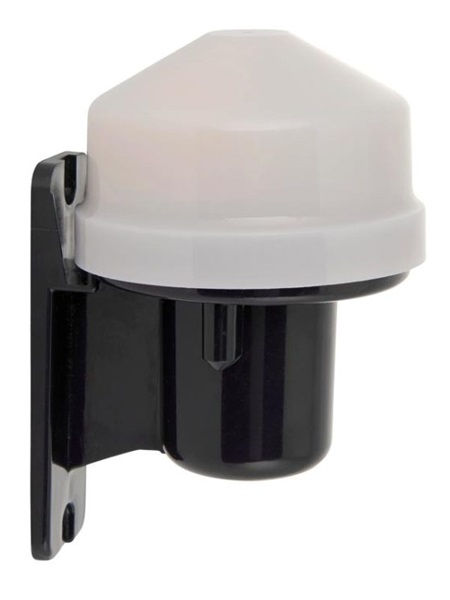
Photocells are devices which senses the ambient light levels and will switch a light on at dusk and deactivate at dawn automatically hence they are also known as dusk to dawn sensors. They work by utilising a light sensitive material which changes electrical resistance in response to varying light levels.
They offer cost savings by reducing energy consumption and only operate during darkness. By ensuring your outdoor areas are well lit at night time, they can deter intruders and improve visibility. Once fitted, you will never have to remember to turn your outdoor lights off again.
There are also standalone photocells available with a countdown timer included. For example, if you set the timer to 4 hours, once it gets dark, your lights will illuminate, but only for 4 hours, then switch off.
Most PIRs and Microwave sensors also have a built-in photocell meaning that your lights aren’t triggered during the daytime when movement is detected.
Built in or remote sensors
The convenience of having a security light with a built-in sensor eliminates the cost of installing separate remote sensors around your property but there are advantages of having separate remote sensors:
- You can control multiple lights at once using a remote sensor.
- You can install your sensor in specific areas where movement needs to be detected and bring your lights on before you even approach them.
- Standalone sensors will usually have more features such as adjustable sensitivity, adjustable time on and adjustable lux levels.
- The sensors are unobtrusive and give you a huge choice of lights to choose from without altering their aesthetic.
Ultimately, the choice between built-in PIR, Microwave or Photocell sensors depends of your specific needs, budget and desired level of control.
Security lights with manual override control
Many security lights now have a manual override feature. This allows you to have a security light which activates with detected movement, or it can be switched to override meaning it is permanently on.
When you are enjoying your garden as it gets dark, having the option of using your security lights as general lighting stops them from switching on and off. This feature requires your lights to be wired to a separate switch. This can be situated indoors, or outdoors when using a weatherproof switch.
Manual override is usually activated by switching the power off and on twice within 2 seconds. This will turn the luminaire on permanently. To cancel and return to automatic mode, switch the power off for at least 10 seconds.
Shop Lights With Manual Override
Other factors to consider
When selecting a sensor light for your home there are various factors to consider such as:
- Power source
- Whether battery operated solar or wired into an electrical mains supply
- Beam angle of the bulb/lumens output (to determine how much area is illuminated)
- Distance or range that it will detect movement from and sensitivity levels (some models offer multiple settings)
- In addition, it is important to choose one suitable for outdoor use that is protected from adverse weather conditions e.g., weatherproofing and UV resistant if possible.
The installation process will depend on whether it’s wired into the mains or uses solar charged batteries.
For permanent connection you may need an electrician’s assistance, however solar powered units can generally be installed by anyone familiar with basic DIY tasks, although always follow manufacturer instructions carefully when doing so. Once installed make sure that motion sensors are aimed accurately in order not to miss any movements in their detection range. Incorrect alignment can result in random activations which could become annoying over time!
Summary
Motion sensor lights have many advantages such as reduced electricity consumption; improved home security, convenience and cost effectiveness. Their ability to automate lighting operations saves you money and reduces the costs associated with timers.
PIR lights are a low-cost reliable option for most applications. They will enhance your home security and save energy too. They make for excellent security lights and some can be adjusted for sensitivity, activation time and distance.
Microwave sensor lights tend to be slightly more expensive. More usually fitted in bulkhead lights for use in commercial settings or to illuminate a larger area at home. Their sensor is more sensitive and as such can be activated by heavy rain and strong winds. Some can be adjusted for sensitivity and activation time but careful placement is key.
Still got questions or need further advice? Please call 0151 650 2138 to speak directly with one of our lighting specialists. Alternatively, you can ask your question using the contact us form and a member of out team will get back to you promptly.
